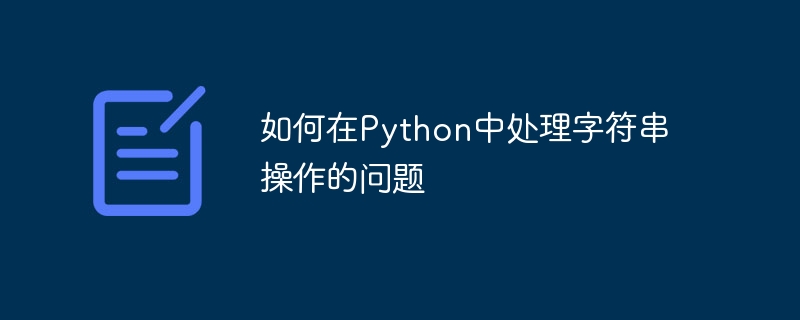如何在Python中處理字串操作的問題

如何在Python中處理字串操作的問題
Python作為一種高階程式語言,具有強大的字串處理能力。在日常開發中,字串操作是非常常見的操作之一。本文將介紹如何在Python中有效率地處理字串,同時附帶具體的程式碼範例。
- 字串的拼接和格式化
字串的拼接是常見的操作,Python提供了多種方式來實作字串拼接。
使用" "號碼進行拼接:
str1 = "Hello" str2 = "World" result = str1 + " " + str2 print(result) # 输出:Hello World
使用「%」進行格式化:
name = "Tom" age = 25 result = "My name is %s, and I'm %d years old." % (name, age) print(result) # 输出:My name is Tom, and I'm 25 years old.
使用format()方法進行格式化:
name = "Tom"
age = 25
result = "My name is {}, and I'm {} years old.".format(name, age)
print(result) # 输出:My name is Tom, and I'm 25 years old.使用f-string進行格式化(Python 3.6以上版本支援):
name = "Tom"
age = 25
result = f"My name is {name}, and I'm {age} years old."
print(result) # 输出:My name is Tom, and I'm 25 years old.- 字串的切片和索引
Python中的字串是一個字元序列,可以透過索引和切片來取得字串中的字元或子字串。
使用索引取得單一字元:
str1 = "Hello" print(str1[0]) # 输出:H print(str1[-1]) # 输出:o
使用切片取得子字串:
str1 = "Hello World" print(str1[6:11]) # 输出:World print(str1[2:]) # 输出:llo World print(str1[:5]) # 输出:Hello print(str1[::-1]) # 输出:dlroW olleH
- 字串的尋找和取代
在處理字元字串時,常常需要尋找特定的字元或子字串,或將特定的字元或子字串替換為其他字元或子字串。
使用find()方法找出子字串的位置:
str1 = "Hello World"
print(str1.find("o")) # 输出:4
print(str1.find("abc")) # 输出:-1(表示未找到)使用replace()方法來取代:
str1 = "Hello World"
result = str1.replace("World", "Python")
print(result) # 输出:Hello Python- 字串的判斷和轉換
Python提供了豐富的方法來判斷字串的特性和進行字串的轉換。
使用isalpha()判斷是否全為字母:
str1 = "Hello" print(str1.isalpha()) # 输出:True str2 = "Hello123" print(str2.isalpha()) # 输出:False
使用isdigit()判斷是否全為數字:
str1 = "123" print(str1.isdigit()) # 输出:True str2 = "Hello123" print(str2.isdigit()) # 输出:False
使用lower()和upper( )轉換大小寫:
str1 = "Hello" print(str1.lower()) # 输出:hello str2 = "WORLD" print(str2.upper()) # 输出:WORLD
- 字串的分割和拼接
Python中,可以使用split()方法將字串分割成多個子字串,也可以使用join()方法將多個子串拼接成一個字串。
使用split()方法分割字串:
str1 = "Hello World" result = str1.split() print(result) # 输出:['Hello', 'World']
使用join()方法拼接字串:
strs = ['Hello', 'World'] result = " ".join(strs) print(result) # 输出:Hello World
透過以上的範例程式碼,我們可以看到Python在字串操作方面非常靈活和強大。透過合理運用字串操作,我們可以更有效率地處理字串。希望本文能對讀者在Python中處理字串操作的問題提供一些幫助。
以上是如何在Python中處理字串操作的問題的詳細內容。更多資訊請關注PHP中文網其他相關文章!

熱AI工具

Undresser.AI Undress
人工智慧驅動的應用程序,用於創建逼真的裸體照片

AI Clothes Remover
用於從照片中去除衣服的線上人工智慧工具。

Undress AI Tool
免費脫衣圖片

Clothoff.io
AI脫衣器

Video Face Swap
使用我們完全免費的人工智慧換臉工具,輕鬆在任何影片中換臉!

熱門文章

熱工具

記事本++7.3.1
好用且免費的程式碼編輯器

SublimeText3漢化版
中文版,非常好用

禪工作室 13.0.1
強大的PHP整合開發環境

Dreamweaver CS6
視覺化網頁開發工具

SublimeText3 Mac版
神級程式碼編輯軟體(SublimeText3)
 PHP中處理字串轉浮點數的最佳實踐
Mar 28, 2024 am 08:18 AM
PHP中處理字串轉浮點數的最佳實踐
Mar 28, 2024 am 08:18 AM
在PHP中處理字串轉浮點數是開發過程中常見的需求,例如從資料庫讀取到的金額欄位是字串類型,需要轉換為浮點數進行數值計算。在這篇文章中,我們將介紹PHP中處理字串轉浮點數的最佳實踐,並給出具體的程式碼範例。首先,我們需要明確一點,PHP中的字串轉浮點數有兩種主要的方式:使用(float)型別轉換或使用(floatval)函數。下面我們將分別來介紹這兩
 深入淺出:GO語言字串轉義與反轉義詳解
Apr 07, 2024 am 10:39 AM
深入淺出:GO語言字串轉義與反轉義詳解
Apr 07, 2024 am 10:39 AM
在 Go語言中,字串轉義以反斜線(\`)加特殊字符表示特殊字符,如換行符(\n)。反轉義用反引號(\`)去除轉義字符,恢復其原始字符,如\n表示實際的換行符。實戰案例展示了轉義、反轉義和反轉義在文件讀取中的應用。
 PHP在字串處理中可能發生的錯誤及其修復方法
May 11, 2023 pm 05:21 PM
PHP在字串處理中可能發生的錯誤及其修復方法
May 11, 2023 pm 05:21 PM
PHP是一種廣泛使用的動態程式語言,它有著廣泛的應用,尤其是在網路應用程式的開發中。其中字串處理是PHP中最常用的功能之一,但很多時候開發人員在字串處理時會遇到各種錯誤和問題。在本文中,我們將探討在PHP字串處理過程中可能會遇到的幾種常見問題以及解決方法。字元編碼問題在處理字串時,一個常見的問題就是字元編碼。有很多不同的字元編碼,其中最常見的是UT
 掌握Go語言的正規表示式和字串處理
Nov 30, 2023 am 09:54 AM
掌握Go語言的正規表示式和字串處理
Nov 30, 2023 am 09:54 AM
Go語言作為一門現代化的程式語言,提供了強大的正規表示式和字串處理功能,使得開發者能夠更有效率地處理字串資料。掌握Go語言的正規表示式和字串處理,對於開發者來說是非常重要的。本文將詳細介紹Go語言中正規表示式的基本概念和用法,以及如何使用Go語言處理字串。一、正規表示式正規表示式是用來描述字串模式的工具,能夠方便地實現字串的匹配、尋找和替換等操
 PHP字串處理:去除所有空格的方法詳解
Mar 23, 2024 pm 06:51 PM
PHP字串處理:去除所有空格的方法詳解
Mar 23, 2024 pm 06:51 PM
PHP是一種強大的程式語言,廣泛應用於Web開發。在Web開發過程中,經常會遇到需要處理字串的情況,其中去除字串中的空格是一種常見的需求。本文將詳細介紹在PHP中去除字串所有空格的方法,並提供具體的程式碼範例。一、使用str_replace函數str_replace函數是PHP中常用的字串替換函數,可以將指定字元替換為另一個字元。透過使用該函數,可以
 如何使用正規表示式在 PHP 中將字串中的特定字元刪除
Jun 22, 2023 pm 03:46 PM
如何使用正規表示式在 PHP 中將字串中的特定字元刪除
Jun 22, 2023 pm 03:46 PM
在PHP中,使用正規表示式可以輕鬆刪除字串中的特定字元。正規表示式是一個強大的工具,它可以幫助我們根據指定的模式來匹配和操作文字。在本篇文章中,我們將會介紹如何使用正規表示式將字串中的特定字元刪除,以及如何使用PHP中的preg_replace函數來實現這一目標。使用正則表達式替換特定的字符正則表達式中的“.”標識任何單個字符,我們可以利用
 使用Python在字串中在數字和字母之間添加空格
Aug 31, 2023 pm 11:41 PM
使用Python在字串中在數字和字母之間添加空格
Aug 31, 2023 pm 11:41 PM
處理包含數字和字母組合的字串時,在數字和字母之間插入空格可能會很有用。新增此空格可以提高字串的可讀性和格式,使其更易於解釋和使用。此外,我們將探索一種使用Python實現此目的的技術。 Python提供了強大的字串操作工具,我們將使用re模組,它是用於處理正規表示式的內建模組。正規表示式允許我們根據特定模式來匹配和操作字串,使其成為解決此任務的理想選擇。此外,我們需要安裝re模組,它提供了使用正規表示式所需的功能。如果您尚未安裝,請開啟終端機或命令提示字元並執行以下命令−xpipinstallr
 掌握GO語言字串轉義與反轉義的奧秘
Apr 07, 2024 pm 04:33 PM
掌握GO語言字串轉義與反轉義的奧秘
Apr 07, 2024 pm 04:33 PM
字串轉義使用反斜線將特殊字元表示為轉義序列,而反轉義將轉義序列還原為實際字元。 Go語言支援以下轉義序列:\n(換行符號)、\t(製表符)、\r(回車符)、\f(換頁符號)、\a(警報)、\b(退格)、\v(垂直製表符),此外還有反斜線本身、單引號和雙引號。 Raw字串文字使用反引號括起來,不會轉義任何字元。轉義字元在HTML程式碼和JSON資料中很有用,用於顯示或反轉義特殊字元。






